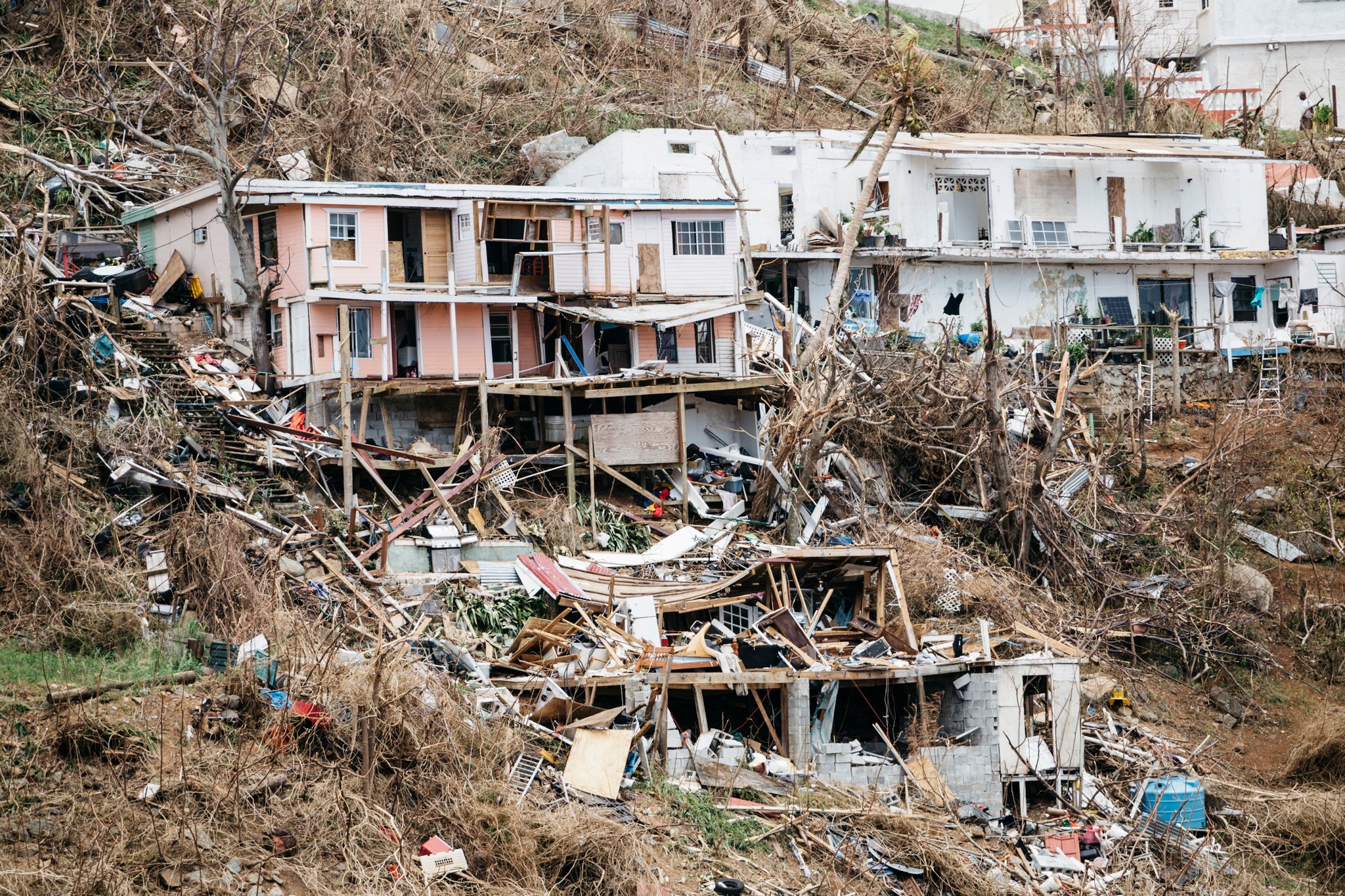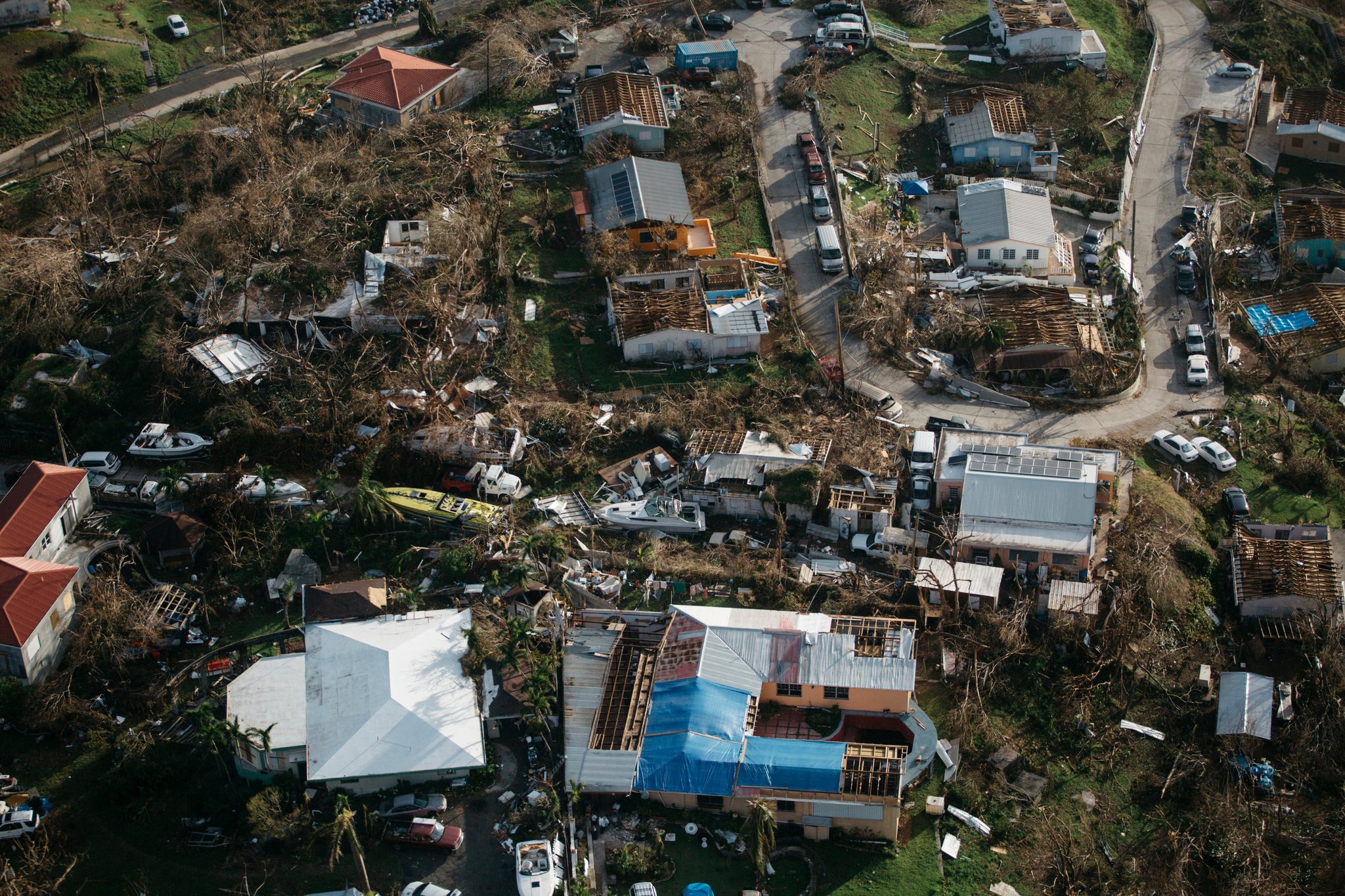
REALITY SETS IN: With no help from the federal or local government seven days after the passing of Category 5 storm Hurricane Irma, St. Thomas residents move into “survival mode” in order to get by. WSTA-AM 1340 Lucky 13’s Addie Ottley said Monday that the bulk FEMA relief supplies had been sent to St. Croix, rather than St. Thomas and he openly questioned what “our leadership” was doing.
[ad name=”HTML-68″]ANNA’S RETREAT, St. Thomas — With residents ignoring the loosely enforced curfew here and lining up hours before the makeshift pantries opened, it was clear Monday that many were still going to end the day hungry.
All some of them could do was walk around neighborhoods smelling for cooking and pleading for the kindness of strangers.
“It’s survival mode right now,” said Kaleem Stephens, a 30-year-old construction worker in St. Thomas. He was left without a home and had on the same clothes — a white t-shirt, gray basketball shorts and black basketball shoes — he was wearing when Hurricane Irma hit the island Wednesday.
As most Americans nervously watching the path of Hurricane Irma, the territory looked like little more than marks on a map as the Cat 5 storm moved its way to the mainland.
But on Monday, as Irma dropped below hurricane strength and most Floridians counted themselves lucky, it became clear that the country had a humanitarian crisis on its hands in one of its tropical paradises. Whilst Florida and the rest of the country breathed a sigh of relief that Hurricane Irma would not be hitting them this time, it is never guaranteed. Serious weather conditions such as these can occur at any time and can cause serious injury as well as damage to your home. If after a storm you have found that your roof or other aspects of your home need repairing, you should contact a company like J.O.N. Construction, Inc who can make sure that all the necessary repairs are completed on your house to ensure that it remains a safe place to live.
Residents on St. John, which suffered even greater damage than St. Thomas, estimated that 80 percent of its structures had been extensively damaged, and those who had not evacuated were huddling together in groups of up to 50 in buildings that had no roofs.
With many roads impassible, some had to walk for miles to food pantries to pick up meals-ready-to-eat (MREs) and bottled water dropped by American military helicopters.
Communication was spotty. Over a dozen cars were parked at one point Monday at the top of a hill near Tutu in St. Thomas, one of the few high spots with cellphone signals, where people could make calls to seek help or try to figure out ways to get off the island.
Islanders tuned into radios in their cars to listen to government notices and other broadcasts. A caller to a radio show requested more tarps delivered to her part of the island for use as roofs. One radio host read messages submitted by people in Washington, Atlanta and Miami worried about family members here.
“Leopold Lewis, we’re trying to hear from you, Monique is trying to hear about you,” the host said.
At least four people had been killed but the lack of communication led to widespread concern about who lived and who died. “What I would say to folks concerned about their family members is: I wouldn’t yet consider them missing, I would consider them incommunicado,” Gov. Kenneth Mapp, said on Sunday.
Many here complained that their suffering was being ignored, by the United States and local government.
“The government is treating us terrible,” said Ureen Smith, 55, who lived next to a building in which one of the deaths occurred. “Locals are mad they’re not hearing talk about St. Thomas.”
Reports that looters were acting with impunity circulated on social media, and one broadly-shared story about guns being stolen from a Customs building in St. John was quickly denied by the authorities. But the situation was not helped by the fact that 70 percent of the island’s police force had their homes damaged or destroyed, Mapp alibied for the cops.
Denise Obaggy, 47, who has lived on St. John for six years and was on the island when Irma hit, said she had seen shops — including a jewelry store — that had been looted, and ATMs that had been stolen.
“There are homeless people directing traffic,” she said. “Where are the police? The police aren’t doing anything.”
Still, there were signs Monday of a massive government and private relief effort lurching into action.
The U.S. military deployed an aircraft carrier off St. Croix as a staging ship for aid to the Virgin Islands and Puerto Rico, as well as to St. Martin and other devastated foreign territories, said Thomas Bossert, President Trump’s homeland security adviser, at a White House briefing Monday afternoon.
At a news conference, Mapp said that Trump had told him he “loves the Virgin Islands” and would visit over the next six or seven days “to see first-hand the damage.
Nearly 5,000 American service members were being sent to the islands, including 600 marines who arrived on St. Thomas on Monday.
Throughout the day, helicopters delivered supplies by air and the Coast Guard by boat. The federal Health Department was taking more than 100 dialysis patients to Puerto Rico.
The effort was amplified by private ferries and volunteers who took residents who wanted to leave to St. Croix, which received less damage, or Puerto Rico. Royal Caribbean and Norwegian were sending cruise ships with supplies — bags of ice and tarps were in particular demand — and to take stranded tourists out.
About 300 people were staying in five Red Cross shelters, the organization said.
But how well the islands, which have about 100,000 full-time residents, would be able to manage a long-term relief effort was unclear.
Purchased by the United States 100 years ago from Denmark for $25 million in gold, the islands have long been buoyed by tourism.
But the closing of the St. Croix oil refinery in January 2012 wiped out the biggest part of the Virgin Islands’ tax base, contributing to a debt crisis similar to that of Puerto Rico, our largest regional neighbor.
For years the territory borrowed from its catastrophe insurance fund to meet other demands.
And now the islands’ status as an easy vacation getaway seems, for now, to be in doubt.
Mary Anne Steele, who operates a charter snorkeling and sailing company in St. John with her husband, said that of the 125 boats in Coral Bay, only 20 or 25 were still afloat, she said, including the couple’s boat.
Worried that their rented frame house would not make it through the storm, Steele her husband and sons, ages 2 and 4, rode it out at St. John Inn in the Cruz Bay section.
When the roof started to leak in the building they were staying in, they crawled under a mattress. “It sounded like a waterfall coming in,” she said.
Just as the roof was about to rip off their room, they ran to another building in the complex and broke into a storage room with a concrete roof.
By the next day, the family became worried because people they considered looters had arrived at the hotel. They moved to a friend’s house on the other end of the island. “People were setting fires to vehicles in one area to divert the attention of authorities,” she said. “It was definitely feeling very scary.”
The smell of dead animals was everywhere. The family was running out of food and water. By climbing on top of a building, Ms. Steele was able to get one bar on her phone and contact friends in St. Croix, who arrived by boat to rescue her.
Darryl Potter, 33, a St. Thomas resident, said that thefts were not surprising, given the catastrophic conditions in the island.
The heat and lack of cellular reception, he said, were also altering residents’ tempers.
“They’re being antsy,” he said, adding that small brawls often break out at the lines of food distribution centers. “People are trying to survive.”
https://www.nytimes.com/2017/09/12/opinion/irma-virgin-islands-damage.html

